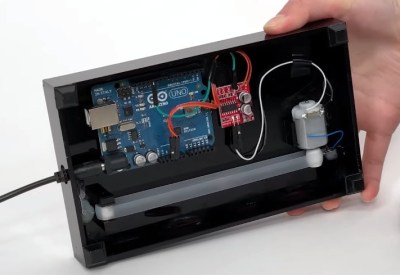Mylar has a lot of useful properties, and as such as see it pop up pretty often, not just in DIY projects but in our day-to-day lives. But until today, we’ve never seen a piece of Mylar jump up and try to get our attention. But that’s precisely the promise offered by ElectriPop, a fascinating project from Carnegie Mellon University’s Future Interfaces Group.
The core principle at work here is fairly simple. When electrostatically charged, a strip of Mylar can be made to lift up vertically into the air. Cut that strip down the center, and the two sides will repel each other and produce a “Y” shape. By expanding on that concept with enough carefully placed cuts, it’s possible to create surprisingly complex three dimensional shapes that pop up once a charge is applied. A certain degree of motion can even be introduced by adjusting the input power. The video after the break offers several examples of this principle in action: such as a 3D flower that either stands up tall or wilts in relation to an external source of data, or an avatar that flails its arms wildly to get the user’s attention.

As the relationship between the nested cuts, slits, and holes placed in the Mylar sheet and the final 3D shape isn’t particularly intuitive, the team has developed a visualization tool that can be used in conjunction with existing vector art programs to create a 2D cut file. Once you’re satisfied the design will inflate to the intended shape, it can quickly be implemented with a vinyl cutter or laser. The low barrier to entry makes this project particularly well suited for DIY replication, and we’re eager to see how the maker community could put this concept to work.
There are plenty of ways that you can charge up your new shape-changing Mylar display, but we particularly liked the team’s miniature Arduino-controlled Van de Graaff generator. It may represent the smallest and most simplistic implementation of this classic high-voltage generator that we’ve ever seen, and looks like a fun little project in itself.
ElectriPop was developed by [Cathy Mengying Fang], [Jianzhe Gu], and [Lining Yao] in collaboration with the director of the Future Interfaces Group, [Chris Harrison]. Readers may recall that in 2018 we covered VibroSight, another project from [Chris] and his students, which ultimately was scaled up to demonstrate laser non-contact sensing on city-scale just last year. Stay tuned for more from this innovative lab in the near future.
















Huh but..that shiny, mirror finish does not look like my empty PET coke bottle, there is some metal in it no? Strange omission?
That’s because Mylar isn’t PET….it’s Mylar.
I think Mylar is PET. It’s often got a thin layer of aluminum on it, e.g. potato chip bag.
The conductive foil will be helping it “pop” quickly but a non-conductive plastic that was very thin, and reasonably rigid and doesn’t stick to the surface would work but possibly a little slower to “pop”.
According to the video it’s “metallized PET, commonly called Mylar”.
Wacky waving, arm flailing electrical mylar man! It’s neat but does it have any practical applications, aside from cheap chinese toys?
Cheap Chinese bug-zapping toys.
new technology is typically critiqued with, “.. but there’s no practical application”. I could think of dozens of applications for this. Put next to solar panels, tuned to reflect additional sunlight in, while keeping birds off. Deaf person phone ring alert system (add sunlight/spotlight). Bird alert system from soffit: unfurl to stop birds crashing into windows. Cat toy w kitty bringing the “static”. Micro satellite cooling systems. Nanite joint mechanisms/models. Invisible animal fencing. Happy Friday
I was just wondering what applications it could have and some of these sound interesting, thanks.
I could see satellite/ space applications being quite useful for things like solar sails and sheilds.
But I wonder if it could also be useful in compliant mechanisms like the following
Veritasium: Why Machines That Bend Are Better
https://youtu.be/97t7Xj_iBv0
https://hackaday.com/2022/05/06/flexures-make-this-six-dof-positioner-accurate-to-the-micron-level/
Pranking.
Make moving spider, ghost, kali, abortion, demon, zombie, balrog, dragon…rest of prank left as exercise for student.
Video spectators ‘evacuating’. Fun for all, they will laugh at themselves later.
Making something complicated will require some hard parts, maybe regular robotics, and more then one piece of Mylar. Also a 555.
A “space blanket” from the local dollar store or camping store is a good source of cheap mylar, if you want to play around with it.
This post inspired me to order a van de graaff generator
I wonder how long the Uno or Pi are going to last while right beside a van de graaff generator!
Well I wonder why there even there.